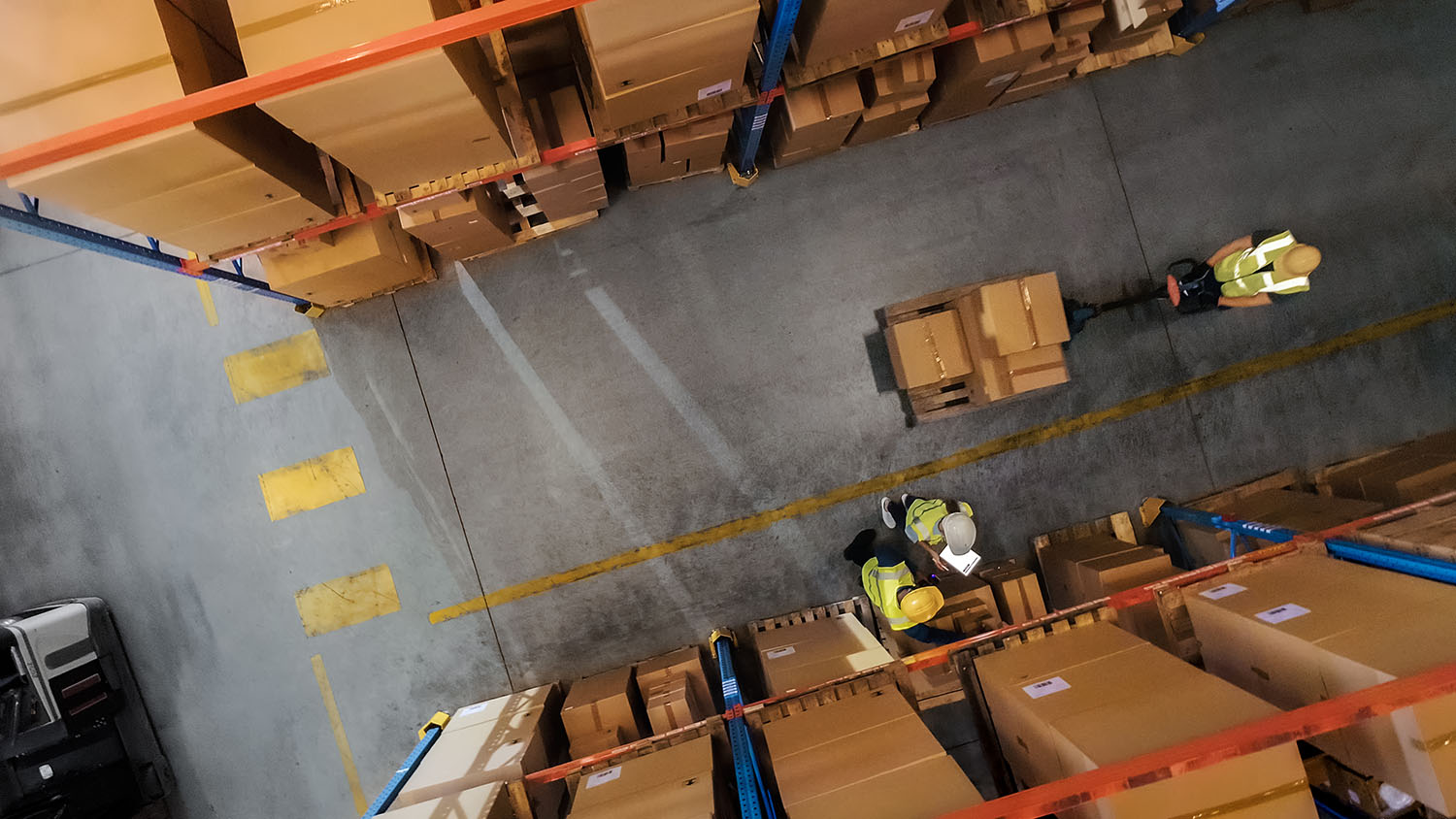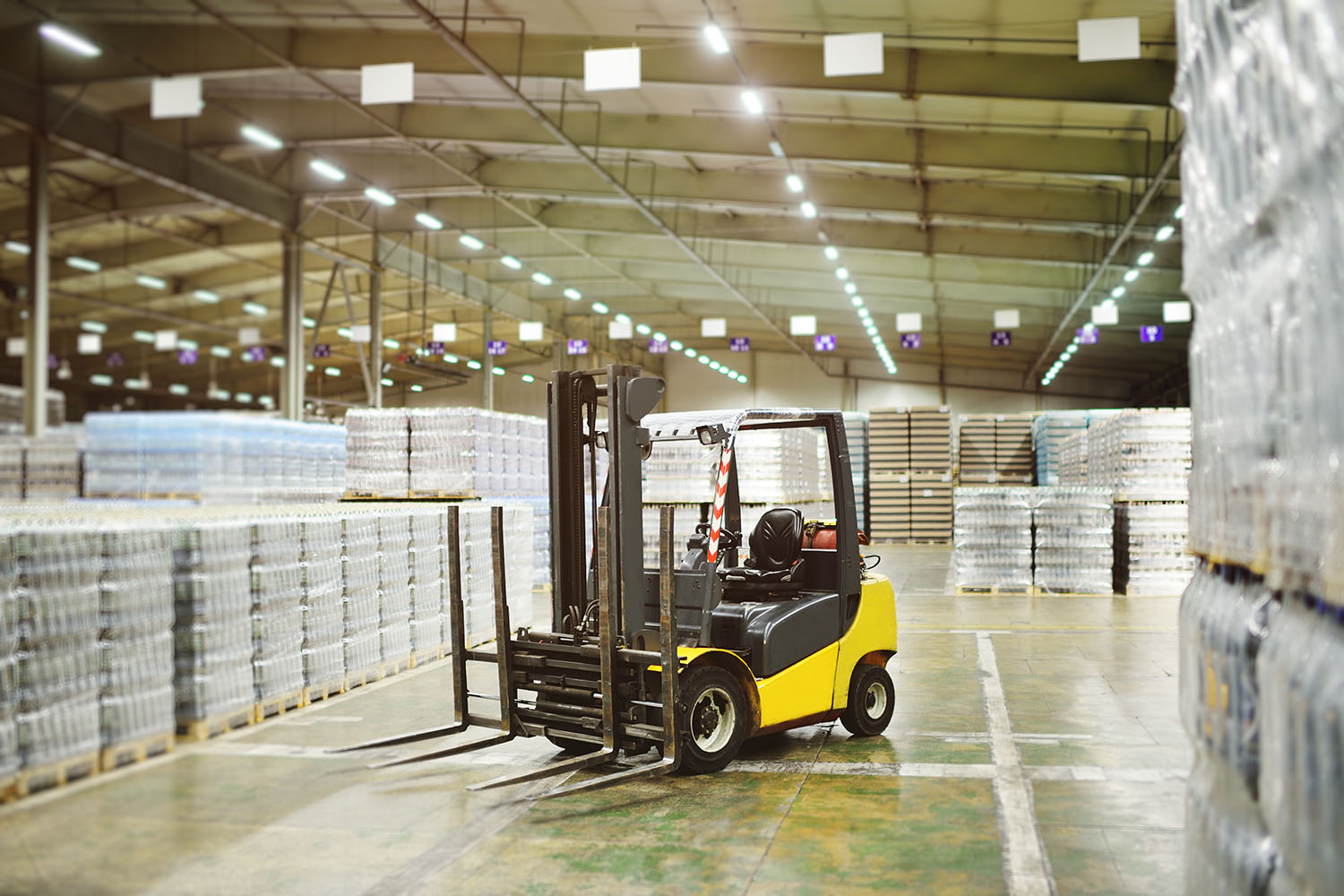As logistics grow complex, 3PLs need smarter solutions to overcome growing inventories, labor costs, order fulfillment delays, and unsustainable CO₂ emissions. Smart warehousing is an umbrella term for emerging technological innovations driving the trend for a more fully automated and efficient warehouse.
You won’t hear workers in a warehouse talking about “smart warehousing.” But inside more advanced 3PLs, you will hear plenty about the specific technologies the term covers: automated storage and retrieval systems (AS/RS), IoT-enabled inventory tracking, AI, warehouse management systems (WMS), and robotics.
According to NTT Data, nearly 50% of 3PL customers expect two-day delivery to their consumers with real-time transparency. It is a system of smart warehousing that allows warehouses to meet those expectations. Only with intelligent technologies can a warehouse obtain real-time information about every product and worker and only with automation can it process orders faster with minimal workforce involved.
This article will explore how smart warehousing works for 3PLs and the benefits of using automated technologies like warehouse management systems (WMS) to meet logistics demands.
What is Smart Warehousing?
Smart warehousing combines cutting-edge technologies and operational management practices (order picking, packing) to automate manual tasks and run prediction models for faster order fulfillment.
From inventory counting to packing and shipping, smart warehouses use AI, real-time WMS, IoT devices, cloud computing, and robots to automate or simplify tasks.
This allows your workers to focus on high-value tasks such as quality control inspection or troubleshooting automation failures, and adapt to the fluctuating e-commerce market demands.
Here are some important characteristics of smart warehousing:
- Information Interconnection: Smart warehouses use IoT (Internet of Things) devices like sensors and cameras, cyber-physical systems (a combination of computational intelligence and smart physical assets), and other technologies to enable real-time information sharing across logistics nodes (networks).
- Equipment Automation: Smart warehouses deploy automated systems like robotic picking, conveyor belts, and AGVs (Automated Guided Vehicles) for precise task handling.
- Process Integration: It integrates warehouse processes to ensure coordination, eliminate order delays, and address new operational challenges such as picking accuracy or real-time inventory tracking.
- Environmental Sustainability: Emerging technologies focus on reducing energy consumption and carbon emissions, ensuring eco-friendly operations at all management levels.
Here’s a look into the operations management system in smart warehousing:
Image Source: Journal of Vocational Education Research
Benefits of Smart Warehousing
Here’s why 3PLs use smart warehousing:
Real-Time Visibility
Smart warehouses leverage IoT and WMS solutions for real-time visibility into inventory, order processing, and worker performance. Barcode technology and sensors track items, providing clients with up-to-the-minute logistics data.
Operational Scalability
The smart warehousing model uses machine learning and algorithms to optimize your warehouse’s physical and digital systems. This helps improve your operational practices like inventory management, low energy consumption, order picking accuracy, warehouse slotting optimization, and compliance audits.
Predictive Analysis
Smart warehouses run prediction models by analyzing data trends and forecasting demand. This ensures precise inventory planning and accurate resource allocation across multiple clients.
Emerging technologies like machine learning models easily integrate into existing operations and perform deeper algorithmic analyses to improve your operations, such as storage utilization or order fulfillment rate.
For example, Da Vinci’s cloud-based WMS uses algorithmic capabilities for forecasting, efficient order picking, and batch handling.
Reduced Downtime
Smart warehousing uses IoT devices, smart sensors, RFID (Radio Frequency Identification) tags, and cameras to track inventory and goods movement across the facility. This model also provides predictive maintenance for expensive equipment to avoid unexpected breakdowns or workflow disruption.
But you need WMS software to unify and centralize data collected on these IoT devices.
Da Vinci’s WMS is a great use case that synchronizes with your existing system to collect and report real-time data on your warehouse’s operations.
Optimized Space Utilization
Smart warehousing uses automated storage and retrieval systems (AS/RS), conveyor belts, and robotic arms to store, pick, and retrieve items from pallets. This maximizes storage space and speeds up order picking.
Lower Risk of Injury
The Occupational Safety and Health Administration (OSHA) reports that forklifts are involved in 35,000 to 62,000 injuries annually in the United States. Smart warehousing handles all heavy-unloading tasks, assigns bulky items in wide-isle zones, and places high-demand items on lower shelves to prevent worker strain or injury.
Challenges in Implementing Smart Warehousing (and How to Overcome Them)
Let’s explore some challenges 3PLs face when implementing smart warehousing and how you can overcome them.
High Initial and Maintenance Costs
Transitioning to automation equipment, IoT devices, and software can be expensive. For example, implementing systems like RFID and AGVs can require substantial investment in hardware, infrastructure, and workers’ training.
How can warehouses save on initial costs:
- Use modular systems that scale with your warehouse’s needs and budget instead of overhauling everything.
- You can opt for Robotics-as-a-Service (RaaS), which allows warehouses to rent robots rather than purchasing them outright.
- You can apply a hybrid model that integrates smart technologies into your current systems to reduce the need for a full rebuild.
Data Security Concerns
Smart warehouses are prone to cyber-attacks and data breaches due to outdated software use. According to IBM Data Breach Report 2024, the global average cost of a data breach rose to $4.88 million, reflecting the increasing stakes of securing interconnected systems like IoT.
Here’s how you can avoid vulnerabilities:
- Use a cloud-based WMS like Da Vinci to assign permission-based roles and block third-party access to your warehouse ecosystem.
- Apply advanced encryption standards (AES) and protocols like HTTPS for secure web communication and SSL for encryption during data transfer.
- Make sure your IoT devices are up-to-date and have strong two-factor authentication protocols.
Process Integration Issues
Integrating multiple systems in a traditional warehouse is hard. Every system has different standards and processes. This causes workflow disruptions, human errors, and order fulfillment delays.
Here’s how smart warehouses overcome this challenge:
- Choose systems with an open architecture for compatibility.
- Invest in middleware solutions like cloud-based servers that act as a bridge between different technologies.
- Standardize your tech stack by working with vendors who offer comprehensive, end-to-end solutions.
Da Vinci’s WMS is a great use case to resolve this challenge. Our team tailors WMS code to meet your warehousing demands, making integration easy and up-to-date with modern technologies.
Knowledge and Skill Gaps
Smart warehouses require skilled personnel to design, implement, and maintain smart technologies. This includes robotics engineers or IoT specialists with the right skills to identify maintenance issues or design comprehensive plans for better operational flow.
This gap slows down implementation and makes troubleshooting harder.
Here’s how you can overcome knowledge gaps in smart warehousing:
- Use easy, user-friendly interface systems to reduce the learning curve for employees.
- Offer ongoing training programs tailored to new technologies.
- Document processes from experienced employees in a centralized knowledge base to provide step-by-step guidance and speed up onboarding for new workers.
- Use cloud-based WMS to integrate knowledge so workers can easily access guides.
Environmental and Sustainability Pressures
According to the McKinsey report, warehousing accounts for 20% of global logistics CO₂ emissions. Smart warehouses have an even larger carbon footprint due to 24/7 operations and high energy consumption from HVAC (Heating, Ventilation, and Air Conditioning) systems, material handling equipment, and automated systems like AS/RS.
As sustainability becomes a priority, many 3PL customers now expect warehouses to adopt eco-friendly practices to meet customer demands.
Here’s how smart warehouses can adopt sustainable practices to meet ISO (International Standard Organization) standards:
- Use low-energy lighting (LED) and optimized HVAC systems to reduce energy demands.
- Invest in renewable energy like rooftop solar panels to reduce energy consumption and save space.
- Optimize warehouse layouts for faster material flow and reduce operational energy required for equipment like AS/RS systems.
Retrofitting Challenges
Retrofitting means upgrading or modifying existing systems, equipment, or structures with new technology or improvements. Many warehouses, especially those built before 2008, lack energy-saving features like LED lighting and effective insulation. Older warehouses lose significant energy through poor insulation, leading to higher CO₂ emissions.
Retrofitting requires major digital and physical modifications, and outdated systems often struggle to integrate with modern technologies, causing data silos.
Here’s how warehouses can overcome retrofitting challenges:
- You can use WMS to optimize workflows and synchronize legacy systems with new technologies.
- You can upgrade infrastructure gradually, starting with IoT sensors and modular automation tools.
- You can reconfigure storage layouts and material flow to integrate AS/RS and other automated systems.
Real-World Applications of Smart Warehousing
Here’s a practical application of smart warehousing:
Background
Tori Belle Cosmetics, an e-commerce brand, sought to improve its fulfillment rate to meet growing customer demand. The company implemented the cloud-based WMS to overcome their order picking errors and shipping delays.
Results
With cloud-based WMS in place, Tori Belle Cosmetics benefited in the following ways:
- Real-time Inventory Tracking: The company was able to track inventory levels, demand trends, and order status across the facility.
- Save Labor Costs: They could control labor costs by applying workforce management and optimizing automation tools through WMS features.
- Increase Order Fulfillment Rates: They reduced errors and increased order fulfillment rates, leading to higher customer satisfaction.
How to Build a Smart Warehouse: Step-by-Step Guide
Here’s a step-by-step guide on how to build a smart warehouse:
1. Evaluate Current Warehouse Operations
Conduct an assessment of your existing infrastructure, inventory workflows, and order fulfillment steps. Identify challenges like limited traceability, picking delays, or outdated manual processes to help you decide which intelligent technology is best for you.
Da Vinci’s WMS features real-time visibility and advanced reporting capabilities to help you track and pinpoint operational issues. Our software uses smart algorithms to analyze order fulfillment processes to identify loopholes and gaps.
2. Set Clear Objectives
Define what you aim to achieve through smart warehousing such as real-time inventory visibility, labor productivity, or sustainability goals. You can also establish measurable performance metrics such as lead times, order accuracy rates, and energy usage to help you set objectives.
3. Choose the Right Technologies
Once you have set objectives, choose the technology that aligns with your needs and budget. Start with foundational tools like barcode systems or handheld IoT devices to track the movement of real-time goods. Then, gradually expand to advanced technologies as your operations grow.
To connect these systems, you need a cloud-based feature that centralizes real-time data for easy access by employees and customers. Da Vinci’s WMS offers a cost-effective solution that integrates smoothly with your existing systems while supporting new technologies without delays.
With real-time updates and predictive analytics, our software allows workers to manage orders accurately while giving clients full visibility into inventory levels and order status.
4. Redesign Physical Layout
Smart warehousing requires adapting your layout to accommodate automated technologies. For example, if you’re using storage and retrieval systems (AS/RS) and collaborative robots (cobots), you need to palletize your inventory for faster picking and sorting.
5. Phased Deployment of Automation
Start with modular upgrades, such as cost-effective automated picking tools like pick-to-light systems (using light to identify where an item is placed) and barcode scanners for inventory tracking. You can also opt for Robotics-as-a-Service (RaaS) to rent automation tools instead of buying them.
Other ways to phase automation deployment include:
- Focus on high-impact areas like picking or packing for immediate ROI.
- Retrofit existing systems with IoT sensors to improve visibility without replacing equipment.
6. Train and Upskill Workforce
The final step after implementing new technologies requires a skilled workforce. You need to develop training programs for employees, implement user-friendly interfaces, and document your knowledge base for easier smart system adoption.
7. Use Data-Driven Software Applications
Modern warehouses require data-driven software applications like inventory management system, transport management system (TMS), advance planning and scheduling (APS), warehouse management system (WMS), and enterprise resource planning (ERP).
These software align your automated processes with your warehouse objectives, like optimizing storage utilization, grouping orders, choosing picking methods (wave, batch, or zone), or improving picking paths for faster order fulfillment.
Future Trends in Smart Warehousing
The warehouse industry will continue to evolve with customers’ expectations. 3PLs will need to implement newer technologies to optimize labor performance, improve order-picking accuracy, and achieve high fulfillment rates to maintain their reputation.
Here are 5 future trends that will transform how smart warehouses operate:
- Future Connectivity: Future smart warehouses will use Industrial Internet of Things (IIoT) like edge computing, predictive maintenance, and 5G Internet to further improve interconnectivity and operational performance.
- Digital Twin Simulation: Warehouses use digital twin technology (virtual replicas of physical objects) to simulate new technologies before full-scale implementation. In the future, digital twin technology will leverage AI and predictive analysis for personalized simulations.
- Autonomous Support: Autonomous Delivery Vehicles (ADVs) like drones, AGVs, and autonomous trucks will support human workers by handling both repetitive and dynamic tasks.
- Layout Design: Warehouses will implement vertical storage, modular layouts, robotics inventory zones, and renewable energy systems like nuclear power to accommodate new technologies and sustainability.
- Automation-as-a-Service: As logistics grow complex, small warehouses will buy AoS subscriptions based on fluctuating or seasonal demand patterns. This will allow warehouses to automate operations while saving substantial capital investment.
As technologies evolve, warehouses will need smarter end-to-end solutions to accommodate them. Cloud-based servers and software will become important to store and manage large datasets while ensuring faster integration without disruptions.
Learn more on how Da Vinci’s cloud-based WMS features can help you achieve cost-effective and personalized smart warehousing capabilities. Contact our team today.



